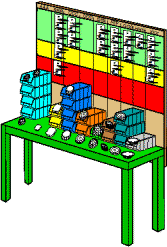Designing The Kanban System
More than A Guess; Less Than A Science
Designing The Kanban System
Preparing for a Kanban scheduling system can be formal with elaborate analyses and simulations. It can also be very informal with fine-tuning done on the production floor. Process Mapping can help understand the underlying process and Value Stream Mapping uses Kanban in many places.We suggest the following Ten Steps for Kanban Design:
1. Analyze Product-Volume For Upstream Work Center/
2. Analyze Downstream Order Patterns
3. Identify Kanban Products
4. Identify Appropriate Lot Sizes
5. Identify Containers
6. Identify Signal Mechanism
7. Specify Stockpoint(s)
8. Specify Initial Kanban Quantities
9. Develop Upstream Scheduling Algorithm
10. Operate Fine tune

Kanban Stockpoint
This figure shows how a stockpoint might look for nine types of small parts using tote boxes for containers.
Daily Operations
In the best systems, operators or teams schedule their own work. They have current and accurate information of downstream production needs. The scheduling bucket is rarely larger than a day. In some systems, it may be only minutes.
Operators examine returning kanban cards or signals to determine where stock is low or high. Aids such as boards with red, yellow and green zones can assist. Knowing the most favorable sequence for changeovers, the operator first schedules items in the red zones. Products in the yellow and green zones then follow.
Operators might also have a list of incoming orders. With this, they identify any unusually large order(s) that will overwhelm the stock.
■ ■ ■ ■ ■ ■ ■


